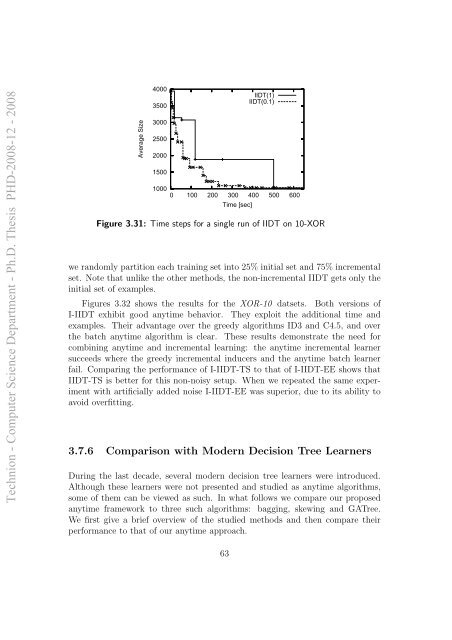anytime algorithms for learning anytime classifiers saher ... - Technion
anytime algorithms for learning anytime classifiers saher ... - Technion
anytime algorithms for learning anytime classifiers saher ... - Technion
You also want an ePaper? Increase the reach of your titles
YUMPU automatically turns print PDFs into web optimized ePapers that Google loves.
<strong>Technion</strong> - Computer Science Department - Ph.D. Thesis PHD-2008-12 - 2008<br />
Average Size<br />
4000<br />
3500<br />
3000<br />
2500<br />
2000<br />
1500<br />
1000<br />
0 100 200 300 400 500 600<br />
Time [sec]<br />
IIDT(1)<br />
IIDT(0.1)<br />
Figure 3.31: Time steps <strong>for</strong> a single run of IIDT on 10-XOR<br />
we randomly partition each training set into 25% initial set and 75% incremental<br />
set. Note that unlike the other methods, the non-incremental IIDT gets only the<br />
initial set of examples.<br />
Figures 3.32 shows the results <strong>for</strong> the XOR-10 datsets. Both versions of<br />
I-IIDT exhibit good <strong>anytime</strong> behavior. They exploit the additional time and<br />
examples. Their advantage over the greedy <strong>algorithms</strong> ID3 and C4.5, and over<br />
the batch <strong>anytime</strong> algorithm is clear. These results demonstrate the need <strong>for</strong><br />
combining <strong>anytime</strong> and incremental <strong>learning</strong>: the <strong>anytime</strong> incremental learner<br />
succeeds where the greedy incremental inducers and the <strong>anytime</strong> batch learner<br />
fail. Comparing the per<strong>for</strong>mance of I-IIDT-TS to that of I-IIDT-EE shows that<br />
IIDT-TS is better <strong>for</strong> this non-noisy setup. When we repeated the same experiment<br />
with artificially added noise I-IIDT-EE was superior, due to its ability to<br />
avoid overfitting.<br />
3.7.6 Comparison with Modern Decision Tree Learners<br />
During the last decade, several modern decision tree learners were introduced.<br />
Although these learners were not presented and studied as <strong>anytime</strong> <strong>algorithms</strong>,<br />
some of them can be viewed as such. In what follows we compare our proposed<br />
<strong>anytime</strong> framework to three such <strong>algorithms</strong>: bagging, skewing and GATree.<br />
We first give a brief overview of the studied methods and then compare their<br />
per<strong>for</strong>mance to that of our <strong>anytime</strong> approach.<br />
63











